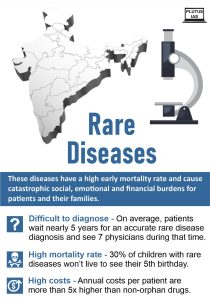30 Nov Rare Diseases
This article covers “Daily Current Affairs” and the topic details “ Rare Diseases”. This topic has relevance in the Social Issues section of the UPSC CSE exam.
For Prelims:
About Rare Diseases?
For Mains:
GS 2: Social Issues
Government Interventions?
Why in the news?
The Health Ministry has ensured the availability of generic drugs to facilitate the care and treatment of four medical conditions: Tyrosinemia-Type 1, Gaucher’s Disease, Wilson’s Disease, and the Dravet-Lennox Gastaut Syndrome.
About Rare Diseases
Rare diseases, also known as orphan diseases, pose unique challenges due to their low prevalence in the population.
Characteristics of Rare Diseases:
- Rare diseases are debilitating lifelong conditions occurring infrequently in the human population.
- WHO defines rare diseases with a prevalence of 1 or less per 1000 population.
- In India, a prevalence of less than 100 patients per 100,000 people is considered as a rare disease.
Examples of Rare Diseases:
- Tyrosinemia-Type 1:
-
-
- A rare autosomal recessive genetic metabolic disorder.
- Characterized by a deficiency of the enzyme fumarylacetoacetate hydrolase (FAH).
- Results in the abnormal accumulation of tyrosine, potentially causing severe liver disease.
-
- Gaucher’s Disease:
-
-
- Characterized by the accumulation of glucocerebroside in organs.
- Organs, particularly the spleen, liver, and bone marrow, enlarge and may suffer impaired function.
-
- Wilson’s Disease:
-
-
- A rare genetic disorder leading to the accumulation of copper in organs.
- Affects the liver, brain, and cornea.
-
- Dravet-Lennox Gastaut Syndrome:
-
- Two distinct types of epileptic syndromes.
- Dravet syndrome: A severe form of epilepsy beginning in infancy.
- Lennox-Gastaut syndrome: Childhood-onset epilepsy with multiple seizure types and cognitive impairment.
Rare Diseases in India:
- Approximately 450 rare diseases identified, with 80% of patients affected by around 350 rare diseases.
- Estimated burden of 80 to 96 million cases annually in India.
- 70-80% of rare diseases are genetic, and the majority remain asymptomatic until later in life.
- Less than 5% of rare diseases in India have available therapies.

Government Interventions:
- National Policy for Rare Diseases, 2021:
-
-
- Aims to lower the incidence and prevalence of rare diseases through an integrated preventive strategy.
- Encompasses awareness generation, screening, and counseling programs.
-
- Production Linked Incentive Scheme 2.0 for Pharmaceuticals:
-
-
- An INR 15,000 Crore initiative supporting orphan drugs development.
- Targets Category 1 pharmaceutical goods in the Production Linked Incentive Scheme.
-
- Central Drugs Standard Control Organisation (CDSCO):
-
-
- Provisions for fast-track processing of applications for rare disease drugs in drug trials and experimental therapies.
- Exemption of application fees for potential drug candidates.
-
- Genomics for Understanding Rare Diseases: India Alliance Network (GUaRDIAN):
-
-
- A non-profit clinical genomics research network.
- Establishes a network of clinicians and scientists for extensive clinical genomics research in India.
-
- Council of Scientific & Industrial Research (CSIR):
-
- Establishes the Indian Genetic Disease Database (IGDD).
- Tracks mutations in causal genes for genetic diseases common in India, providing insights to physicians and researchers.
Rare diseases present significant challenges globally, and India is actively addressing these challenges through policy interventions, financial incentives, and research initiatives. The collaborative efforts of government bodies and research networks aim to enhance awareness, diagnosis, and treatment options for individuals affected by rare diseases in the country.
SOURCE: Generic drugs to treat four rare diseases launched – The Hindu
Q.1 With reference to the rare diseases, consider the following statements:
- Rare diseases are always Zoonotic diseases.
- WHO defines rare diseases with a prevalence of 1 or less per 1000 populations.
Which of the statements given above is/are correct?
(a) 1 only
(b) 2 only
(c) Both 1 and 2
(d) Neither 1 nor 2
ANSWER: B
Q.2 Discuss the unique challenges posed by rare diseases, commonly referred to as orphan diseases, emphasizing their low prevalence in the population.



No Comments